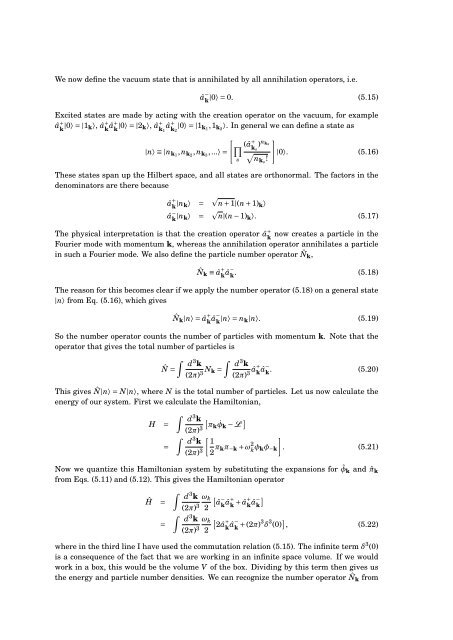Master's Thesis in Theoretical Physics - Universiteit Utrecht
Master's Thesis in Theoretical Physics - Universiteit Utrecht
Master's Thesis in Theoretical Physics - Universiteit Utrecht
You also want an ePaper? Increase the reach of your titles
YUMPU automatically turns print PDFs into web optimized ePapers that Google loves.
We now def<strong>in</strong>e the vacuum state that is annihilated by all annihilation operators, i.e.â − k|0〉 = 0. (5.15)Excited states are made by act<strong>in</strong>g with the creation operator on the vacuum, for exampleâ + k |0〉 = |1 k〉, â + kâ+ k |0〉 = |2 k〉, â + k 1â + k 2|0〉 = |1 k1 ,1 k2 〉. In general we can def<strong>in</strong>e a state as[∏|n〉 ≡ |n k1 , n k2 , n k3 ,...〉 =s(â + ) n ]ksk s√ |0〉. (5.16)nks !These states span up the Hilbert space, and all states are orthonormal. The factors <strong>in</strong> thedenom<strong>in</strong>ators are there becauseâ + k |n k〉 = n + 1|(n + 1) k 〉â − k |n k〉 = n|(n − 1) k 〉. (5.17)The physical <strong>in</strong>terpretation is that the creation operator â + now creates a particle <strong>in</strong> thekFourier mode with momentum k, whereas the annihilation operator annihilates a particle<strong>in</strong> such a Fourier mode. We also def<strong>in</strong>e the particle number operator ˆN k ,ˆN k ≡ â + kâ− k . (5.18)The reason for this becomes clear if we apply the number operator (5.18) on a general state|n〉 from Eq. (5.16), which givesˆN k |n〉 = â + kâ− k |n〉 = n k|n〉. (5.19)So the number operator counts the number of particles with momentum k. Note that theoperator that gives the total number of particles is∫ˆN =d 3 ∫k(2π) 3 N k =d 3 k(2π) 3 â+ kâ− k . (5.20)This gives ˆN|n〉 = N|n〉, where N is the total number of particles. Let us now calculate theenergy of our system. First we calculate the Hamiltonian,H ==∫∫d 3 k [πk(2π) 3 ˙φk − L ]d 3 [ ]k 1(2π) 3 2 π kπ −k + ω 2 k φ kφ −k . (5.21)Now we quantize this Hamiltonian system by substitut<strong>in</strong>g the expansions for ˆφk and ˆπ kfrom Eqs. (5.11) and (5.12). This gives the Hamiltonian operatorĤ ==∫∫d 3 k ω k [â−(2π) 3 2kâ+ k + ]â+ kâ− kd 3 k ω k(2π) 3 2[2â+kâ− k + (2π)3 δ 3 (0) ] , (5.22)where <strong>in</strong> the third l<strong>in</strong>e I have used the commutation relation (5.15). The <strong>in</strong>f<strong>in</strong>ite term δ 3 (0)is a consequence of the fact that we are work<strong>in</strong>g <strong>in</strong> an <strong>in</strong>f<strong>in</strong>ite space volume. If we wouldwork <strong>in</strong> a box, this would be the volume V of the box. Divid<strong>in</strong>g by this term then gives usthe energy and particle number densities. We can recognize the number operator ˆN k from
















